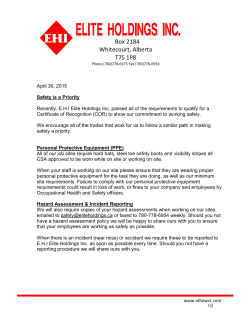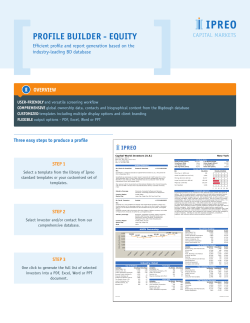
Quarterly Model Portfolio Update
Quarterly Model Portfolio Update
April 10, 2015
As the first quarter came to a close, most of the news items from financial
markets proved to be classic examples of “sound and fury, signifying
nothing.” The S&P 500 Index completed the first quarter with a modest gain
of 0.95% and the U.S. Bond Aggregate Index returned a solid 1.61%.
On March 2nd, the NASDAQ closed at a level of purely historic interest,
eclipsing the 5,000 point mark for the first time since March 2000. This
staggering 15-year break-even period presents a stark warning signal against
sector-focused and undiversified investment strategies.
March also marked the 6-year anniversary of the beginning of the current
bull market. Some “pundits” cite this duration as a sign of caution given that,
since 1950, the average length of a bull market has been only about 4.9 years.
Since March 2013, 108 new all-time closing highs have now been set by the
S&P 500, whereas the 1990-2000 bull market set 308 new highs! Market
cycles simply do not run on predictable clocks based on historical averages.
Every bull market is unique - this one has been fueled by unprecedented
stimulus and historically low interest rates. As Warren Buffet recently noted,
“Market forecasters will fill your ear, but will never fill your wallet.”
In a reversal of much of 2014’s trend, non-U.S. developed stocks, as
measured by the iShares Core MSCI EAFE Index, outperformed their
domestic counterparts with a 7.34% return. As we noted in January, we
believe that maintaining diversification to currently un-loved international
holdings is likely to continue to benefit portfolio performance.
The European Central Bank (ECB) began its own version of quantitative
easing, or “QE”, to try to revive the European economy by making loans
more easily available to businesses and households. Data released by the
ECB in late March, seems to indicate that the plan has been initially effective
and economists are optimistic that European economic growth can accelerate.
U.S. Economy & Interest Rate Observations
The recent March jobs number is simply too important to exclude from our
commentary. According to the Labor Department, the U.S. economy added
only 126,000 jobs in March, just about half of what many economists had
expected. Such weak economic data may cause the Fed to reduce the pace
and magnitude of interest rate increases. Other factors also seem to validate
our prior note that fears of “quickly rising rates are overblown.” For
example, veteran bond manager Jeff Gundlach (who manages one of our
active fixed income holdings) has noted that strong disinflationary pressure
coming from the collapse in oil prices will caution the Fed against raising
rates quickly.
Key Points
Both the S&P 500 and U.S.
bond market have enjoyed
solid, but unremarkable
returns in the first quarter of
2015, returning 0.95% and
1.61% respectively.
International stocks have
shown signs of life, however.
The iShares Core
International index and
iShares MSCI Emerging
Markets Minimum Volatility
index we use in our Core
Portfolios returned 7.34%
and 4.20% respectively
during the quarter.
Rebalancing adjustments
occurred in your accounts(s)
during the first week of
April, affecting your
account’s weighting in small
and mid-cap stocks, and
international bonds.
U.S. Economy & Interest Rate Observations (continued…)
The weak March jobs report caused another bout of “bad news is actually
good news” thinking, as equity markets jumped due to the prospect of rates
remaining low. Currently, we find this to be a perfectly rational reaction as
low interest rates make some investments, especially dividend-paying
stocks, attractive alternatives to bonds. However, long term, this is not a
healthy market dynamic. While low interest rates are akin to ‘piping more
oxygen into a collapsed coalmine’, we need more and higher quality jobs to
see real economic growth. Remember, in that backdrop, modestly rising
rates aren’t fundamentally a bad thing. Initially, consumers could scramble
to make large purchases (such as homes and cars) before rates rise further.
Over time, rising rates can lower liabilities for many pension plans (notably
Xerox’s RIGP and Kodak’s KRIP, in the Rochester area) and retirees will
earn more income on their cash savings.
For now, though, uncertainty about U.S. interest rate policy is likely to be
the main driver of volatility in equity, commodity, and currency markets.
Current Portfolio Stance & Adjustments
Our semi-annual rebalancing review process indicated that all Core
Portfolios were slightly overweight in both small-cap and mid-cap U.S.
stock holdings. Since our last portfolio reallocation in September, these
holdings have outperformed and reached threshold levels that caused us to
re-true those holdings back to their initial target weighting. Conversely, in
models with predominantly equity exposure, we also observed a need to
add to emerging market holdings which have underperformed since these
portfolios were last rebalanced in September.
On the fixed income side of portfolios, international bond holdings were
slightly below their target weightings and also rebalanced. As we noted
above, due to continued European Central Bank QE, we are comfortable
adding to these holdings to maintain their target weighting.
We welcome you to contact us to receive a copy of our recent whitepaper,
How We Rebalance Your Portfolio at NorthLanding Financial
Partners to learn more about our monitoring and rebalancing process.
NorthLanding Financial
Partners, LLC
We are committed to
empowering our clients to
discover and direct action
toward their most
important financial goals.
Our advisors have over 70
years of combined
experience and advanced
credentials in counseling
clients to develop and
implement strategies to
meet their personal and
family financial objectives.
Client Feedback
Did you find this
information helpful?
Is there any information
you would like added to
future Portfolio Updates?
Are there any specific topics
of interest or questions you
have?
We welcome your
feedback!
Email feedback or questions
to:
Melissa@NorthLandingfp.com
NorthLanding Financial
Partners, LLC
90 Linden Oaks, Suite 220
Rochester, NY 14625
(585) 497-5000
www.northlandingfp.com
Also, for further information regarding your current portfolio holdings,
or this most recent update, please contact your advisor.
NorthLanding Financial Partners, Investment Direction Committee
* Performance & yield data are courtesy of Morningstar & iShares and are believed to be accurate as of the date of this publication. Other sources include the Wall St. Journal. All
investment strategies including diversified asset allocation have risk. Past performance of our investment approach and component holdings does not guarantee future results.
Advisory services are offered through NorthLanding Financial Partners, LLC, ("NLFP") Registered Investment Advisor. Securities and some advisory services may also be offered
through Wall Street Financial Group, Inc., ("WSFG") Registered Investment Advisor, member FINRA/SIPC. WSFG and NLFP are independently owned and operated. WSFG did not
assist in the preparation of this memo. While all data is believed to be from reliable sources, accuracy and completeness are not guaranteed.
© Copyright 2025










